Pilgrim59
👑 Exalted Monarch 👑
Khronikon Væborgensk
Lore
Notoriety: Droengr of the Coast
Influence: Foreign faces from beyond the seas, whose intentions are as nebulous as their renown.
Sigrid and her companion's notoriety and their growing strength are measured by their feats in battle and exploration, which in turn constitutes much of their fame. Charted lands, conquests, and reforms also count towards the growth of the sielundr's influence as a whole. While it shows the Tutans' might and advantages, their notoriety can also attract diplomatic concerns and rivalries.
"Power attracts the virtuous and the wicked. A zealot will favor one over the other. A fool will distrust both. But a wise leader will utilize both until they have served their purposes."
-
Richilde of Lunaire, Brecourine Princess
Influence: Foreign faces from beyond the seas, whose intentions are as nebulous as their renown.
Sigrid and her companion's notoriety and their growing strength are measured by their feats in battle and exploration, which in turn constitutes much of their fame. Charted lands, conquests, and reforms also count towards the growth of the sielundr's influence as a whole. While it shows the Tutans' might and advantages, their notoriety can also attract diplomatic concerns and rivalries.
"Power attracts the virtuous and the wicked. A zealot will favor one over the other. A fool will distrust both. But a wise leader will utilize both until they have served their purposes."
-
Richilde of Lunaire, Brecourine Princess
General Records
I. Væborg Chronicle
The Chronicle of Væborg is a small Tutan historical work, written in Old Pelik. It is one of the oldest known attempt to write a coherent account of Tutan history by a Tutan author, covering Sigrid's significant adventures and exploration of the world, and ending with the introduction of Aerilianism in Tuta. The original chronicle covers the time frame of 47 to 75 AC. A later addition from the reign of King Fealwulf of Tuta, to 77 AC when Fealwulf gains the throne of Blackford and united the Karelian princedoms in 89 AC. These additional pages are mostly direct quotes from other sources. To this day, the Væborg Chronicle is well-revered by many northerners, subsequently forging the idea of national identity in the North.
II. Thurisaz Runes
Ancient Tutan traditions allows many of those who are compatible to undergo a rite of passage to test their gifts. The gifted are then allowed to pursue ancient knowledge by visiting shrines and going on pilgrimage to the Lunar Isles to hone their abilities. Thurisaz runes have been used since the beginning of time. By performing sacrifices, one is able to utilize blood magic, which is the main form of magic in pagan Tuta. This is usually done by drawing one's blood to augment the ritual with one's essence - a method to connect one's soul to Solsgard, thereby gaining access to aetherium from the heavenly realm to practice magic.
Runes can be prepared before hand by infusing it into a krozat (a rare type of mineral filled with concentration of aetherium). The krozat, when infused with the appropriate spell, can be deployed immediately by shattering it. This process cuts down one's preparation phase, especially for lengthy incantations and greater spells.
III. Races
THE ANCIENTS
The Ancients were various races that inhabited Grozny long before the Architect descended from the heavens.
Draca Sere - One of the oldest race since the Creation. Believed to be the first inhabitants of Grozny that sailed across the stars, dragons are often feared and worshipped. Draca Sere, a subcategory of the Dracas, are impure dragons that strayed from solitude and sought companionship with the Principate races.
Markai
Markais are humanoids with horns of varying shapes above their head, longer pointed ears, and a slim tail with a pointy end, making them identical to demons in many culture. Many sources claim that they are a subvariation of the Daemons, as the two share similar aetherial traits, as well as their behaviorial past. However, Markai history predates the Fall of the Garden, giving credibility to heir existence before the arrival of the Architect. Vampirism is often considered as a derivative art of the Markai use of blood magic.
THE PRINCIPATE
The Principate is the predominant class of races that came about after the Fall of the Garden. They are considered as the descendants of Astra and Sola (two powerful angels in Aerilian scripture). The principate class only acknowledges common racial categories by their distinctive traits, with countless subraces between them.
Solarian
The principal human race in Grozny, Solarians were said to be created in the image of Sola.
Astrian
The second most prominent race in Grozny, Astrians take after Astra, featuring animalistic features that distinguishes them from the Solarians, while possessing greater aetherium threshold. Their animalistic mutations allow them to better adapt to different biomes.
Minarin
Colloquially known as mountain dwellers, Minarin is often considered as a variation of Solarians. Where they fall short in height, they make up for their brilliant minds and craftsmanship - evident in their elaborate architecture and complex cave systems. Particularly the ingenious designs of the ancient caverns around Makübaal and northern Marethia. Due to their limited aetherial affinities, Minarins lack magical potentials and are less likely to pursue arcane arts.
Lesni
Lesni means "forest people" in ancient Krajowan tongue. Graced with beauty and gifted with the ancient arts of nature, Lesni distinguishes themselves with their elongated ears and high aptitude for innate magical practices.
IV. The Tutan Gods
While many of the ancient pantheon are forgotten, the Three (Aedain, Syr, Mitr) are the Gods that survived the test of time and sought after by the people.
Aedain / Aedayn - The primordial god of gods that is revered for their wisdom and strength. They welcome those that proves themselves valiantly in battle on the Middle World to dine in Solsgard in death.
Syr - The Goddess that harvested the stars and created the land (also known as the Weaver of Fate). She is depicted in full armor in most oral traditions and illustrated variations. Due to this odd detail, she is often associated as the Tutan interpretation of Aerilia.
Mitr - Aedyn and Syr's son that constantly battles the wrath of the stars and the skies. They are worshipped by many sailors for safe voyage across the sea.
Alvis - God of Magic and Wisdom. Patron of knowledge-seeker and scholars. (by Remembrance)
The Chronicle of Væborg is a small Tutan historical work, written in Old Pelik. It is one of the oldest known attempt to write a coherent account of Tutan history by a Tutan author, covering Sigrid's significant adventures and exploration of the world, and ending with the introduction of Aerilianism in Tuta. The original chronicle covers the time frame of 47 to 75 AC. A later addition from the reign of King Fealwulf of Tuta, to 77 AC when Fealwulf gains the throne of Blackford and united the Karelian princedoms in 89 AC. These additional pages are mostly direct quotes from other sources. To this day, the Væborg Chronicle is well-revered by many northerners, subsequently forging the idea of national identity in the North.
II. Thurisaz Runes
Ancient Tutan traditions allows many of those who are compatible to undergo a rite of passage to test their gifts. The gifted are then allowed to pursue ancient knowledge by visiting shrines and going on pilgrimage to the Lunar Isles to hone their abilities. Thurisaz runes have been used since the beginning of time. By performing sacrifices, one is able to utilize blood magic, which is the main form of magic in pagan Tuta. This is usually done by drawing one's blood to augment the ritual with one's essence - a method to connect one's soul to Solsgard, thereby gaining access to aetherium from the heavenly realm to practice magic.
Runes can be prepared before hand by infusing it into a krozat (a rare type of mineral filled with concentration of aetherium). The krozat, when infused with the appropriate spell, can be deployed immediately by shattering it. This process cuts down one's preparation phase, especially for lengthy incantations and greater spells.
III. Races
THE ANCIENTS
The Ancients were various races that inhabited Grozny long before the Architect descended from the heavens.
Draca Sere - One of the oldest race since the Creation. Believed to be the first inhabitants of Grozny that sailed across the stars, dragons are often feared and worshipped. Draca Sere, a subcategory of the Dracas, are impure dragons that strayed from solitude and sought companionship with the Principate races.
Markai
Markais are humanoids with horns of varying shapes above their head, longer pointed ears, and a slim tail with a pointy end, making them identical to demons in many culture. Many sources claim that they are a subvariation of the Daemons, as the two share similar aetherial traits, as well as their behaviorial past. However, Markai history predates the Fall of the Garden, giving credibility to heir existence before the arrival of the Architect. Vampirism is often considered as a derivative art of the Markai use of blood magic.
THE PRINCIPATE
The Principate is the predominant class of races that came about after the Fall of the Garden. They are considered as the descendants of Astra and Sola (two powerful angels in Aerilian scripture). The principate class only acknowledges common racial categories by their distinctive traits, with countless subraces between them.
Solarian
The principal human race in Grozny, Solarians were said to be created in the image of Sola.
Astrian
The second most prominent race in Grozny, Astrians take after Astra, featuring animalistic features that distinguishes them from the Solarians, while possessing greater aetherium threshold. Their animalistic mutations allow them to better adapt to different biomes.
Minarin
Colloquially known as mountain dwellers, Minarin is often considered as a variation of Solarians. Where they fall short in height, they make up for their brilliant minds and craftsmanship - evident in their elaborate architecture and complex cave systems. Particularly the ingenious designs of the ancient caverns around Makübaal and northern Marethia. Due to their limited aetherial affinities, Minarins lack magical potentials and are less likely to pursue arcane arts.
Lesni
Lesni means "forest people" in ancient Krajowan tongue. Graced with beauty and gifted with the ancient arts of nature, Lesni distinguishes themselves with their elongated ears and high aptitude for innate magical practices.
IV. The Tutan Gods
While many of the ancient pantheon are forgotten, the Three (Aedain, Syr, Mitr) are the Gods that survived the test of time and sought after by the people.
Aedain / Aedayn - The primordial god of gods that is revered for their wisdom and strength. They welcome those that proves themselves valiantly in battle on the Middle World to dine in Solsgard in death.
Syr - The Goddess that harvested the stars and created the land (also known as the Weaver of Fate). She is depicted in full armor in most oral traditions and illustrated variations. Due to this odd detail, she is often associated as the Tutan interpretation of Aerilia.
Mitr - Aedyn and Syr's son that constantly battles the wrath of the stars and the skies. They are worshipped by many sailors for safe voyage across the sea.
Alvis - God of Magic and Wisdom. Patron of knowledge-seeker and scholars. (by Remembrance)
Glossary
V. Glossary
Ædayn kichitan - A war cry embraced by Tutans. It roughly translates to "Aedyn waits for us."
Blyden - Pejorative/derogative term for non-humans.
Einherjars - Einherjars are those who have died in battle as a way of redeeming themselves on earth, whose soul would be brought to the heavenly realm of warriors called Solsgard.
Hersir - A Tutan term for frontline centurions and defenders. Typically used to describe a type of versatile warrior that are versatile enough to complement a Skeldvag or lead a cohesive fighting unit.
Hexer - A general Tutan term for mages and arcane practitioners. Hexers are often positioned at the rear where they given ample time to perform complex spells and incantations to manage the flow of battle.
Skeldvag (Shieldwall) - Is a formation of overlapping shields to mitigate projectile or lockdown a frontline. This formation is often employed by sielundrs, and are also used by many nations at the time. Unlike the Ancient Venelians' squared formations, Tutan skeldvag was developed to be more agile.
Sielundr / Sielunde - A universal term for sea pirates and raiders.
Solsgard - Tutan's heavenly realm, where the slain resides. It is considered the greatest honor to dine and fight alongside the Einherjars in preparations for the End Times known as Vortag.
Skol - A Tutan exclamation in a toasting ceremony, also practiced by Dargins.
Ulfsark - A Tutan term for combat specialists that augments a skeldvag or fight independently. Unlike hersirs, ulfsarks are often employed to flank or carry out counterattacks.
Vortag - The Tutan word which translates roughly to "The Day of Fate", generally perceived as the end of the world.
Notable Figures
VI. Noteworthy Personage
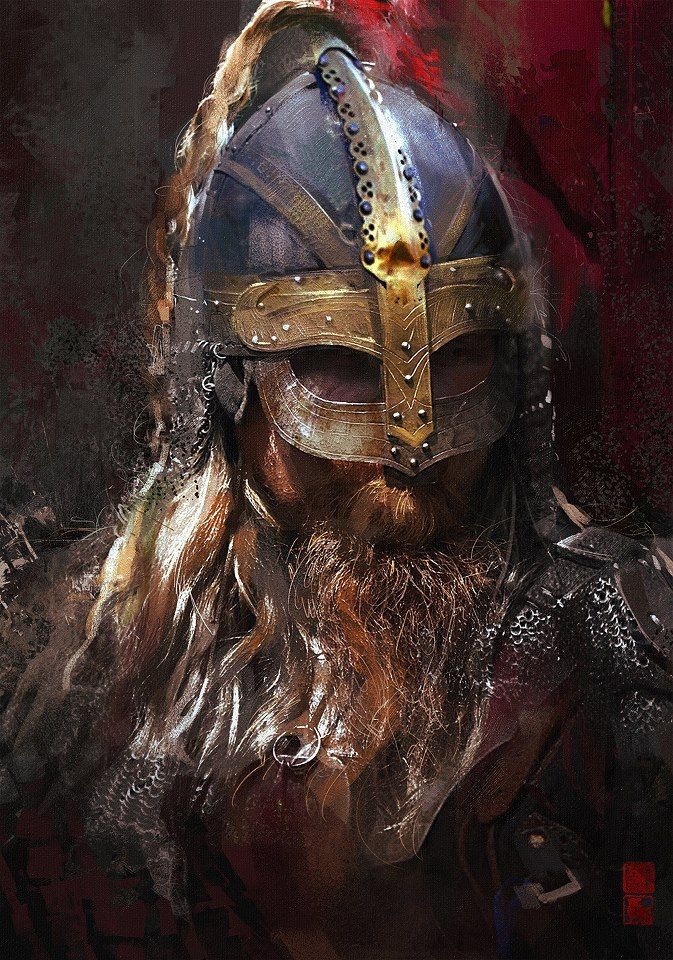
Hargrimm of Halmstad
“the Stonewall”
Allegiance: Vaeborg (Tuta)
Age: 30
Height: 6'5” (195 cm)
“(grunts)”
-
Departure from Vaeborg.
Record:
The personal guard of Jarl Sten, Hargrimm Stonewall earned his name for his tall stature and resilient fighting style. It was said that no man survived a challenge to combat with Hargrimm. That was, until Sigrid's arrival. According to the legend, when the latter was refused an audience with the Jarl of Vaeborg, Hargrimm was the first to step forth and challenge Sigrid to a duel. Sigrid, bearing the tooth of Aedayn in her hand, managed to wound and defeat the hearty champion. Ever since the ordeal, the young woman earned Hargrimm's trust, as the latter is often seen accompanying Sigrid when she was given a role in the Jarl's hall.
Despite his grand profile and robust strength as a warrior, the man is most reticent in the matter of words. Perceived to be a curse from the gods, Hargrimm only ever response with action, rather than words. Rarely seen outside of his armor, the mute warrior's mood and personality remains a mystery to most. Some would say that he is Solsgard's lost Einherjar, cursed to wander on the earth, denied of Aedayn's light.
Hargrimm is a versatile fighter, without a particular attachment to a signature edged weapon. Instead, he would often pluck the enemy's weapons from their hands and use it against them. The only tool he often utilize on the field is a Tutan round-shield, which he bears to ward off projectiles and complement a skeldvag. Earning his moniker via his cohesive performance within a formation, Hargrimm is a vetted defender and an effective frontline companion.
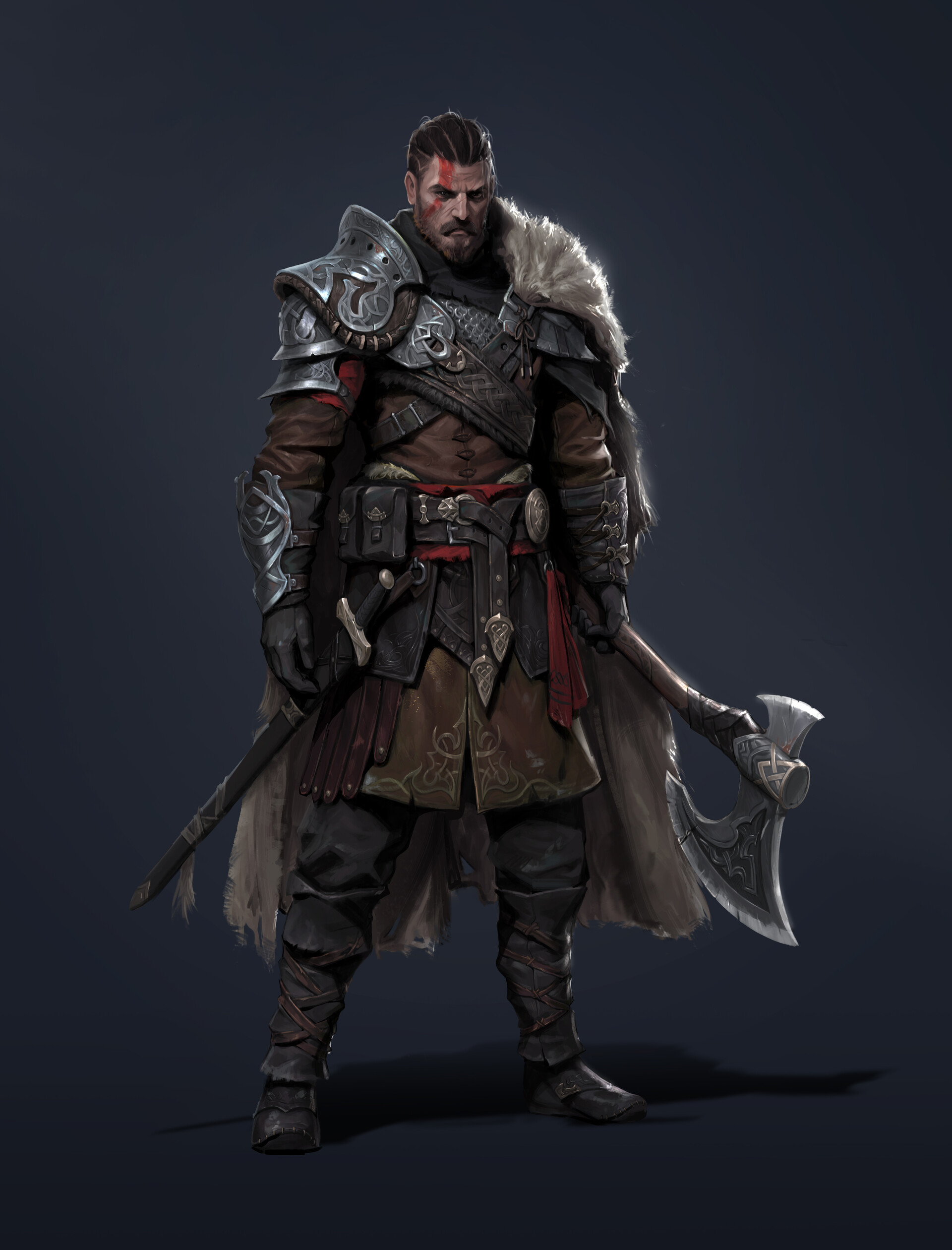
Sten Mavenson
Allegiance: Vaeborg (Tuta)
Age: 36
Height: 6'1” (185 cm)
“A pact with the Armaighrs? You mock me, Sigrid!”
-
Fall 50 AC.
Record:
The Jarl of Vaeborg. Sten, Son of Maven the Black, is a cunning and ambitious ruler. A renowned warrior, Sten fought in several wars against men and beasts in order to protect his interests. With Sigrid's arrival, Sten saw an opportunity to expand his territories in Tuta. While the two shared the same prowess, Sten and Sigrid did not shared the same vision for Tuta. For the past few years, Sten used Sigrid's abilities to settle disputes and rivalries, culminating in Sigrid's resolve to leave Tuta in search of new lands and interests. Concerned for his position of power without Sigrid's presence, Sten opposed the young warrior's ideas to sail to the World's Edge, bent on keeping Sigrid by his side.
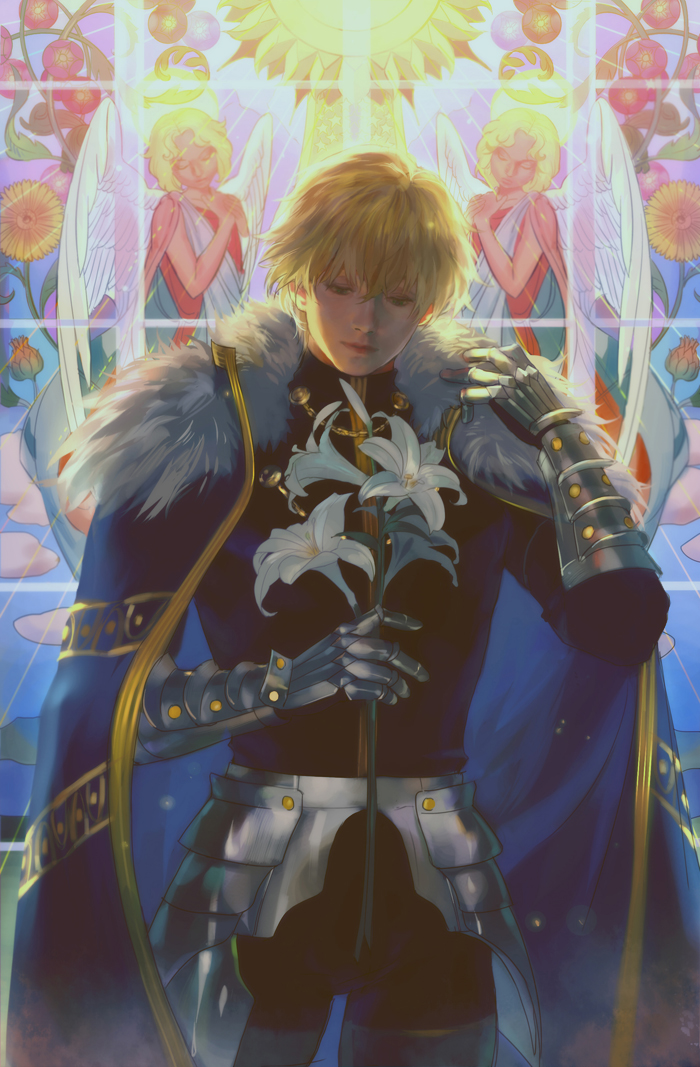
Oswald of Sunderland
“the Brave”
Allegiance: Kingdom of Sunderland (Albion)
Age: 25
Height: 5’10” (177 cm)
“I will never forgive the Child of the Raven. Sunderland will send them back to the depths of the sea from whence they came!”
-
Oswald to his men at Grimsby, 49 AC
Record:
The son of Aedelwulf, Oswald has been raised a pious and earnest fighter. Unlike his father's militant way of solving issues, Oswald remained diplomatic towards his peers, making him a reliable ally for many. His interests, however, resided within agricultural and technological developments, in hopes of improving the welfare and production of his homeland. An agricultural enthusiast, Oswald is on good terms with the peasant, and most popular with the non-nobility class. Due to his innovative ideas and inventions, Oswald helped to transform the method of land cultivation after years of working with peasants and laborers alike. Oswald and Aedelwulf's relationship can only be described as a distant and disagreeable one, for the latter was poised on total conquest of Albion, while Oswald wishes to empower his kingdom via economic prosperity. Their differing ideals caused them to be at odds with one another. Yet, despite this fact, Oswald remained loyal to his father.
A devout Aerilian, Oswald befriended the Bishop of Grimsby, Roland, and the two sought to transform the land with greater farming tools and the Aerilian gospel. Their friendship helped to usher in an age where many were able to see bountiful harvests and religious enlightenment. Having fought side by side in Aedelwulf's wars, the two shared a brotherly bond greater than that of Oswald's relationship with his siblings. While his brothers and sisters vied for the throne, Oswald remained indifferent to the idea of being king, remaining steadfast in his dream to cultivate the land and build a prosperous kingdom from the foundations of agricultural and educational pursuits. When the sielundes threatened the peace, however, Oswald was the first to answer the call. In the Canons of Ashbury, it was said that Prince Oswald was the first to march to battle initially with only his retainers and volunteers, later joined by hundreds of militias and troops when word came of his action, all of whom were inspired by his bravery to follow him into battle without hesitation.

Roland
“the Crusader”
Allegiance: Kingdom of Sunderland (Albion)
Age: 29
Height: 5’8” (172 cm)
“Should you require an ally or a friend, I can function as both, you know that. But this sielundr threat, I haven't the slightest mind if this is truly Aerilia's will.”
-
Roland to Oswald.
Record:
A young Albish bishop that served alongside Oswald in King Aedelwulf's wars. A pragmatic, albeit unorthodox man of faith, Roland is a devout soldier of Aerilia. Trained in the arts of war and well-versed in sacred texts and scriptures, Roland is often perceived as a saint of his time - particularly during the Tutan invasion of Albion. A brother to Prince Oswald, the two are most effective in battle in one another's presence. Often times, Oswald would consult with Roland pertaining to religious and realm affairs. While Roland is not a direct member of Sunderland's court politics, he nevertheless holds a substantial amount of influence over the clergy factions. With Oswald's help, the man was able to bridge the gap of differences between the common folks and that of the church - resulting in Grimsby's gradual but effective advancement.
Unlike Oswald, Roland despises the Tutans with a passion, holding an unwavering faith that earned him the epithet of "the Crusader." An ally to Oswald, Roland often heeds the prince's words, knowing that their universal outlook is an advantage that he did not possess to rule the land. While the man holds little ambitions for power, Roland clings to the tenets of his faith in a conservative manner, refusing to compromise even in the slightest with those that does not accept the gospels of Aerilia.
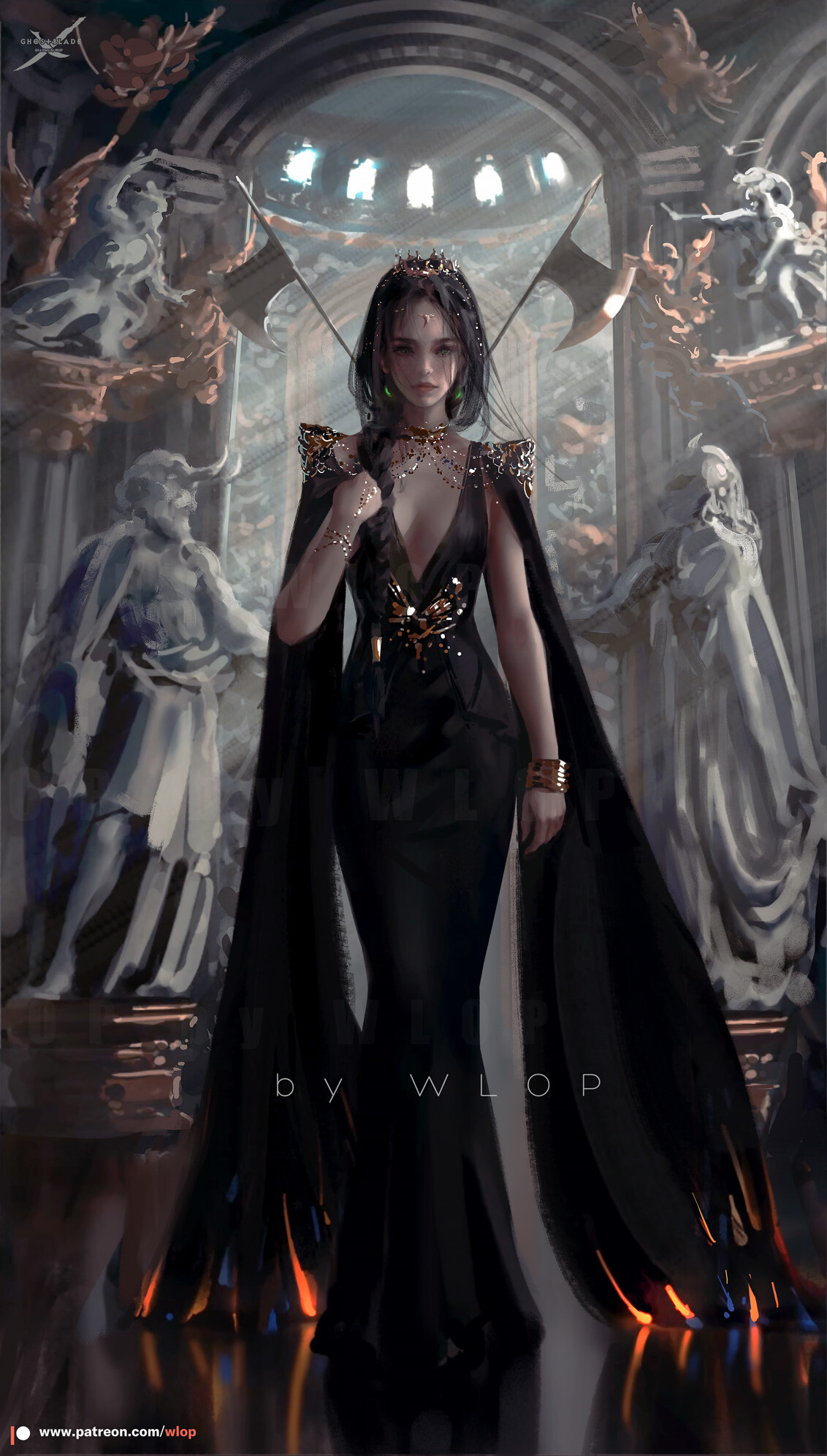
Richilde of Lunaire
Allegiance: Kingdom of Brecouria (Venelia)
Age: 17
Height: 5’5” (165 cm)
“You have have your swords, but I have my tricks. Now kneel, imbeciles!”
-
Richilde to her assailants.
Record:
The daughter of King Landen the Elder of Brecouria, Richilde is often described as a lethal politician. Sporting a variety of facades for different circumstances as well as her rare arcane gift, the princess is feared for her unpredictability and ruthlessness. Ever since a young age, Richilde has been tutored personally by her father's capable attendants. Upon discoveries of her natural compatibility with Venelian divination, Richilde was sent to Verdan to hone her gifts. Upon her return to Brecouria after three years of arcane studies, Richilde quickly entered the world of politics at the age of seventeen, wrestling for favors of the court nobles to solidify her status. During the tumultuous change of wind in the court, Richilde was responsible for uprooting more than twenty nobles that schemed and plotted to defect to their neighboring state. Despite their considerable influence and connections, Richilde executed them without hesitation before her father could decide on their sentences. Fearful of his own daughter, King Landen attempted to prohibit her presence in court by naming her the Abbess of St. Keed's Chapel, instead of marrying her off to a distant kingdom. Her siblings were quick to abandon her, refusing to intervene in their father's decision.
Resentful of her father's decision, despite her profound loyalty to her father, the princess kept her unspoken piece, but poised on vengeance. As she served as Abbess of St. Keed's Chapel, Richilde also began to plot against her father, in a bid to make herself the ruler of Brecouria. Viewing her siblings as potential obstacles, Richilde bided her time, as she began gathering allies for her cause.
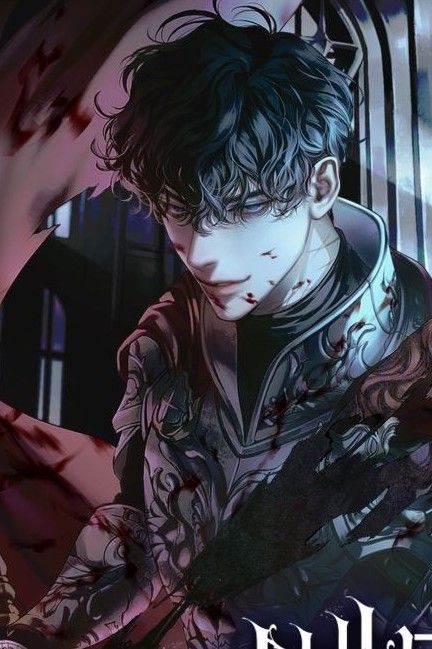
Aurelian I of Havenreach
“the Ironblood”
Allegiance: Kingdom of Haven (Venelia)
Age: 23
Height: 6'0” (182 cm)
“Tutans. They live only for today, without concerns for tomorrow's troubles. And that makes them dangerous, Lord Friedhelm.”
-
Battle of Anthem, Winter 57 AC.
Record:
A prince of the Principality of Haven, Aurelian lived in Havenreach for most of his life. Like many of his time, he would pick up on the sword and fought in many wars in the name of his country. Growing up, the man was exposed to various subjects of studies as he began to befriend travelling merchants and scholars. Augmented with knowledge, the man went on to fight in foreign kingdoms as a mercenary captain. After a few years traveling and fighting, Aurelian returned to Haven to serve as a stateman. Working with the nobles, he was able to persuade his subjects to enact his policies. When his father fell ill, the young Aurelian took the matters of the realm into his own hands. Straying from the principles of docile cooperation with the neighboring states, Aurelian would work to militarize Haven, despite its status as a client state of the Kingdom of Reisdorf.
A resolute politician and a powerful warrior, Aurelian's authority quickly grew in his father's absence. While his intentions are unclear, many speculated his plan to either overthrow Valderman, King of Reisdorf and declare Haven an independent state or preparing for defense against an Brecourine incursion.
Last edited:

